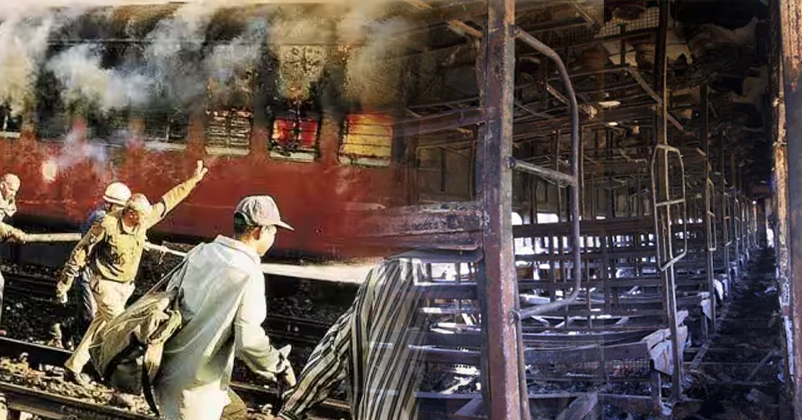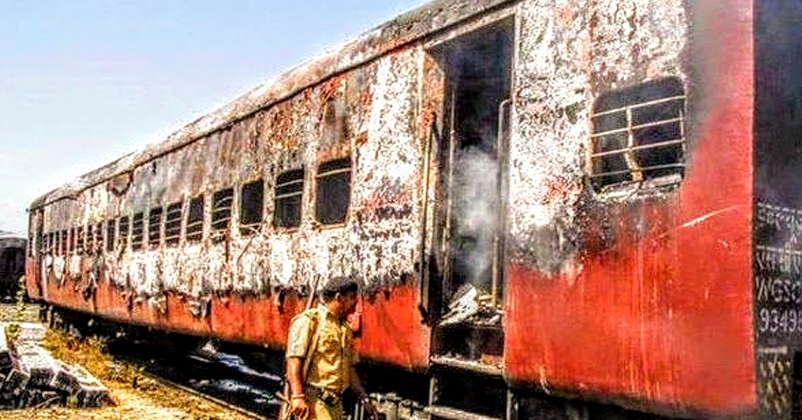‘For Godhra, It Wasn’t First Case Of Burning Alive Hindu Community Members’: The Event That Triggered 2002 Riots
27 Feb 2024 05:31:47

On Wednesday (11 December 2019), Nanavati-Mehta commission report on 2002 Gujarat Riots was placed in the state assembly by Minister of State for Home PradeepsinhJadeja, five years after it was submitted…..
A one-member commission was constituted by the Gujarat government in 2002 itself, however, it was subsequently reconstituted with former Supreme Court judge Justice G T Nanavati as its chairman and former Gujarat High Court Justice K G Shah as member. After Justice Shah died, Justice Akshay Mehta took his place.
The terms of reference of the commission were also expanded beyond inquiring into the cause of the Godhara train-burning incident and subsequent communal violence, bringing in its purview the role and conduct of the then Chief Minister NarendraModi, other ministers and police officers in the riots.
After the riots which took lives of over 1,000 people, Indian intelligentsia overwhelmingly blamed the NarendraModi-led government as complicit in the violence, and termed the incident as “ethnic cleansing”, “state terrorism” and “pogrom” against Muslims instead of communal riots.
However, the Nanavati-Mehta commission absolved the then state administration, ministers and police officers from any complicity, direct or in direct, and also ruled out any conspiracy to organise the large-scale riots. It refused to call the riots as a result of any “pre-planned conspiracy” or “orchestrated violence”.
In its report comprising of 1,500 pages and nine volumes, the commission states that “there is no evidence to show that these attacks were either inspired or instigated or abated by any minister of the State."
Another allegation made by the Left-dominated academia was that the Godhra train-burning incident - the event that sparked the violence in the state - was either an accident or an ‘inside-job’ - a formality before the pre-planned violence against Muslims could be committed.
The Nanavati-Mehta commission report rejects the above propositions and blames the Godhra incident as the trigger for the communal violence in the state.
“On an overall consideration of the entire material, the commission finds that the communal riots which followed the Godhra incident were really by way of an aftermath of those incidents,” the report reads.
“Because of the Godhra incident, large sections of Hindu community became very angry and ultimately indulged in violent attacks on Muslims and their properties,” it added.

Godhara train burning
On 27 February 2002, fifty-nine Hindu pilgrims, returning from Ayodhya after a religious ceremony at the Ram Temple site were burnt alive in the S-6 coach of Sabarmati Express. The victims included 25 women, 25 children and nine men.
The special fast track court, which tried the Godhra train burning case, gave its judgement in 2011, and agreed that the fire in the S-6 coach was neither an accident nor an ‘inside-job’.
The court noted that a large number of local Muslims did gather “within minutes” of stopping the Sabarmati Express on the outskirts of the railway station with stocks of petrol with them.
The court agreed with the prosecution case that the perpetrators had collected the stocks of petrol the previous night, after the meeting at Aman Guest House.
Had petrol not been kept ready in loose form in carboys the previous night near Aman Guest House, “it would not have been possible to reach with carboys containing petrol in a huge quantity immediately, that is within 5 to 10 minutes, near coach S-6,” the court observed.
The court found a ‘pre-planned conspiracy’ to target the Hindu pilgrims because otherwise “it would not have been possible to gather Muslim persons with deadly weapons within five to six minutes and reach near “A” cabin on the railway track” after the train was made to stop by chain pulling a second time. The court further observed that the attack was not a random attack on S-6, but was specifically targeted at the karsevaks returning from Ayodhya.
“Shouting of slogans by the assailants and announcement over a loudspeaker from a nearby mosque also clearly suggest motive and pre-plan,” it noted.
The defence lawyer argued that the attacks weren’t pre-planned but a spontaneous reaction to the alleged “misbehaviour” by the karsevaks with some Muslims on the Godhra station platform.
The court rejected this argument saying that earlier other such skirmishes didn’t result in such a carnage. Also, the details of the quarrel between the kar-sevaks and Muslim vendors, and the allegations of their misbehaviour with Muslim women remains unsubstantiated.
The court noted that the absconding accused SalimPanwala and accused Mehboob Ahmed alias Latiko took advantage of the alleged misbehaviour by karsevaks with Muslim girls.
“They raised shouts, called Muslim people from the nearby area of Signal Falia, misleading [them] that karsevaks were abducting Muslim girl from inside the train, and also instructed [them] to stop the train by pulling the chain,” the judgement said.
“Immediately a mob of more than 900 Muslim people attacked the train with sticks, iron pipes, iron rods, dhariyas, guptis, acid bulbs, burning rags, and the crowd was instigated by announcements over loudspeakers from the nearby Ali Masjid”.
The judge added “by creating such tense atmosphere, the passengers were prevented from jumping out of the train.”
The judge also made it a point to bring out the history of the Godhra city with Muslim population almost equal to the Hindus.
“Godhra is known for its history of communal riots. For Godhra, this is not the first incident of burning alive innocent persons belonging to the Hindu community,” he said.
The judge mentioned around 10 incidents in Godhra between 1965 and 1992, in which Hindus were “burnt alive and shops and houses came to be destroyed by fire.”